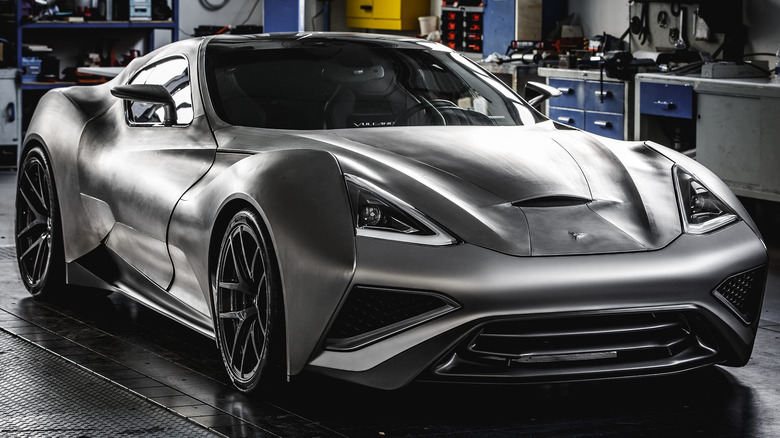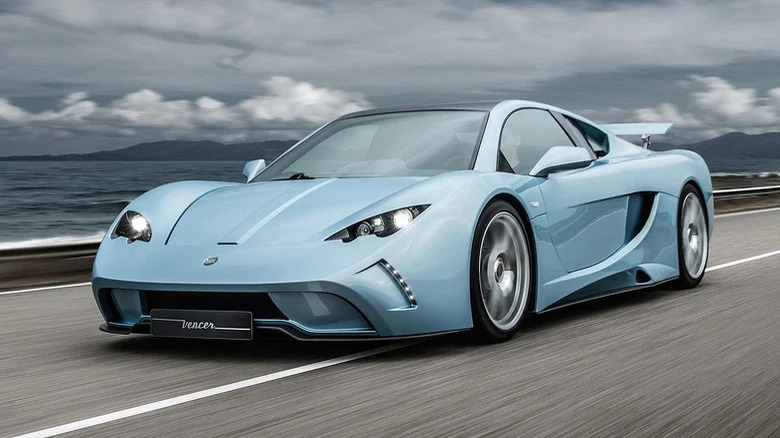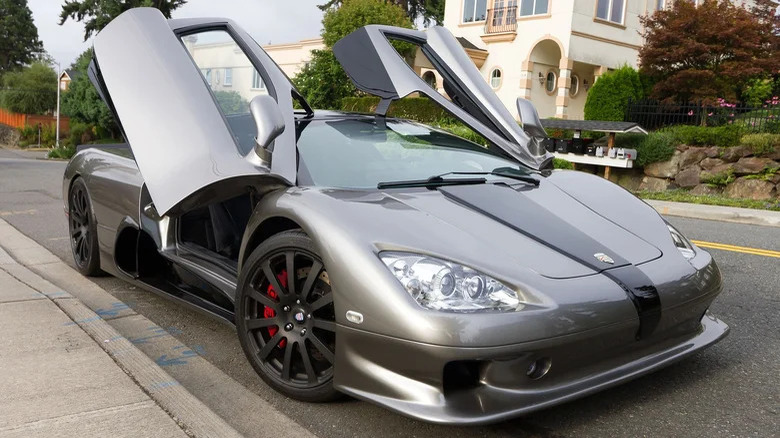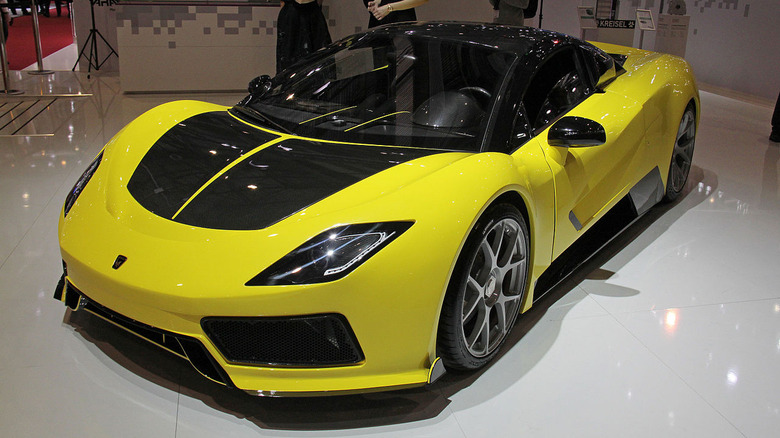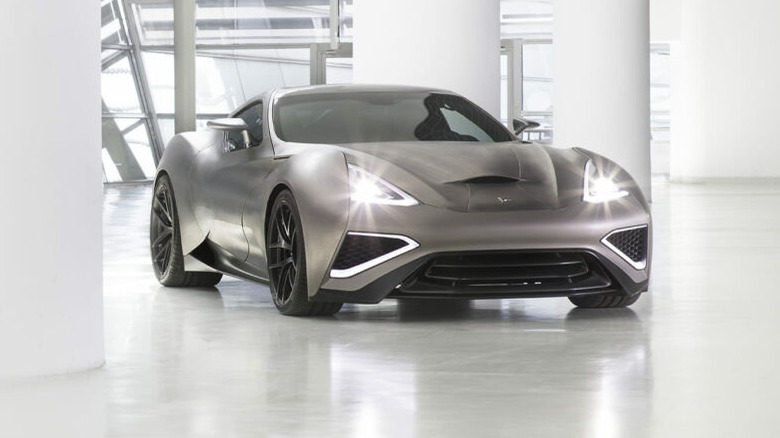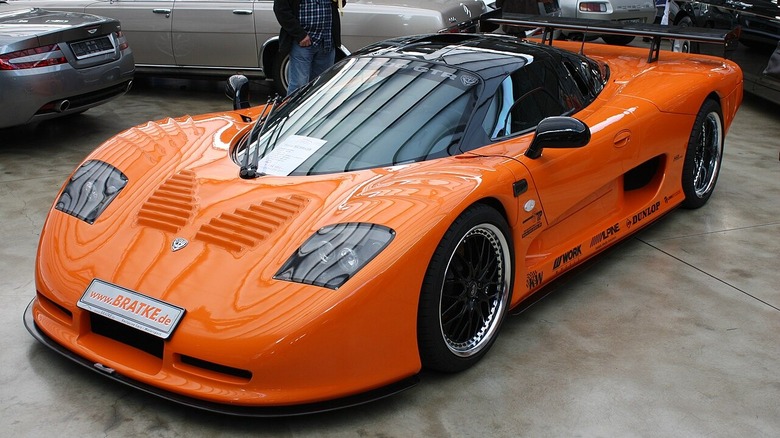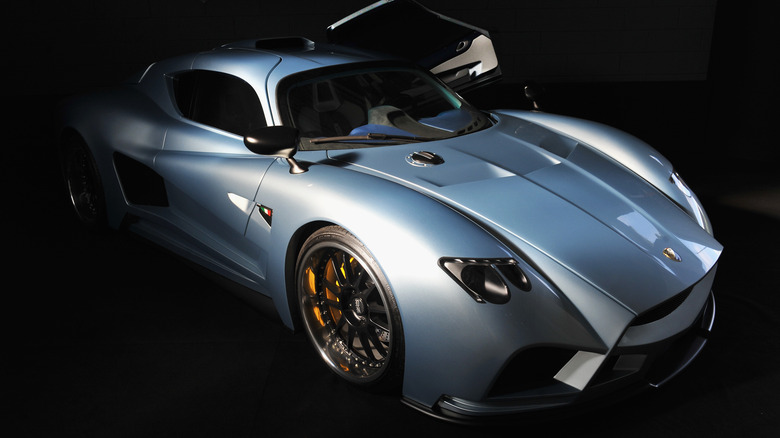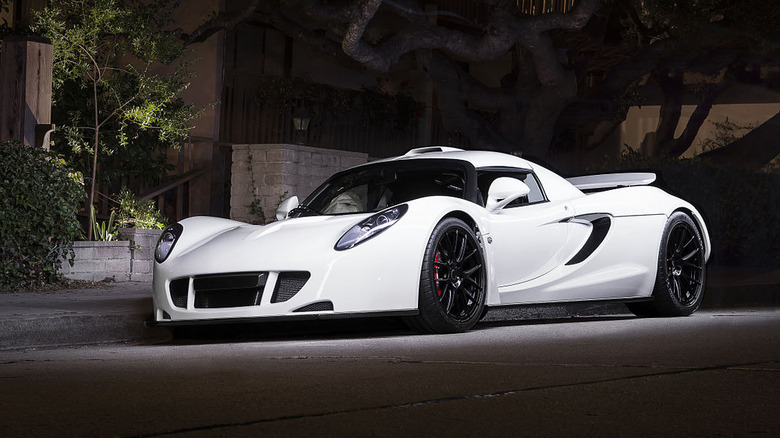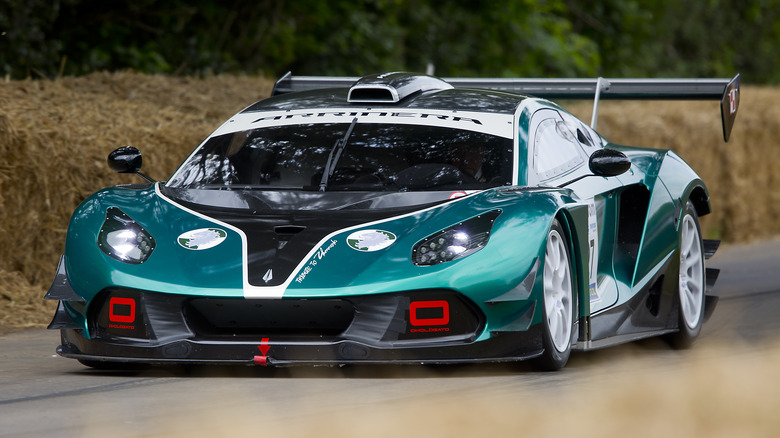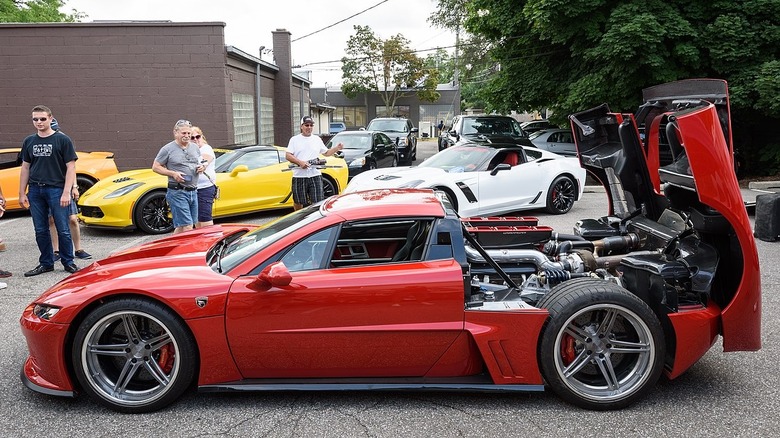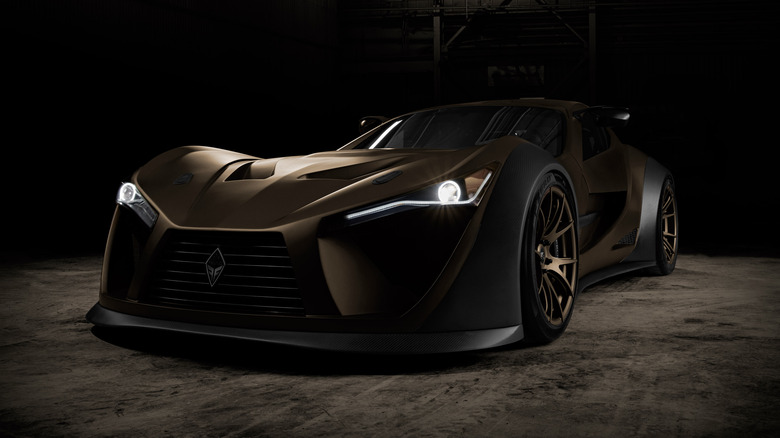10 Exotic Supercars With General Motors LS V8 Engines
The General Motors LS V8 engine can be found under the hood of a variety of GM-branded vehicles, from the Chevy Corvette to the Pontiac Grand Prix GXP. It was first unveiled in 1997 and in the decades since has firmly established itself as one of the most modifiable engines on the market as well as a top performer in stock form. In turn, a large aftermarket has grown around the LS engine family, with a wide range of off-the-shelf parts available for builders to considerably boost an engine's power output.
As a bonus, the durable construction and straightforward design of the LS engines make them both reliable and compact. This combination of desirable attributes has made them so popular with all kinds of project car builders, from restomod builds to drift car projects. It's also made them the engine of choice for several startup supercar makers, who prize the LS for its high tunability and affordable starting price. These exotic supercars hide a much less exotic LS engine under their swooping bodywork — not that you'd know by looking at them.
Vencer Sarthe
At first glance, the Vencer Sarthe is a typical low-volume European supercar. It's sleek, inspired by classic Le Mans racers, with its bodywork made entirely from carbon fiber. It's also quick, with a 0-60 mph time in the mid-three second range and a top speed in excess of 200 mph. Designed with purists in mind, there are no controlling electronic safety nets and a manual transmission sending power to the rear wheels. In its quest to keep production costs at manageable levels, however, Vencer chose to source the Sarthe's engine from a distinctly un-European supplier.
At the car's heart sat a 6.3L LS V8, modified by renowned American tuner Hennessey and featuring an Eaton supercharger. This gave the car an output of 622 horsepower – and given the LS engine's tuning potential, there would have been plenty of scope to increase that power output for more demanding buyers. Unfortunately for Vencer, however, those buyers never came: despite receiving a positive reception from the motoring press at the time of its release, the Sarthe never managed to find its footing in the crowded supercar market. The company closed its factory a mere two years after the car launched, with only two examples of the car sold during that time.
SSC Ultimate Aero TT
American supercars in general tend not to get as much recognition as they arguably deserve. The SSC Ultimate Aero TT is a prime example. It was, for several years, officially the fastest car in the world. It beat competition from Koenigsegg and Bugatti to claim the title, recording a top speed of 256 mph in 2007. The previous record holder, the Bugatti Veyron, had reached 254 mph.
The Ultimate Aero TT kept its crown as the world's fastest car until 2010, when the Veyron Super Sport reclaimed the title. That unprecedented speed wouldn't have been possible without the SSC's twin-turbocharged LS V8 engine, which delivered nearly 1,200 horsepower. It was also a very rare car, with only 24 examples ever built. However, it never made much of a lasting impression on supercar collectors despite its exotic credentials.
Reviewers at the time of its launch criticized its styling as unoriginal and dated, while deriding its build quality as on par with that of a cheap economy car. The SSC brand itself was also caught in the crosshairs for daring to launch a car costing over half a million dollars with no track record or heritage to draw on. That combination of weaknesses ensured that it never became as renowned as its chief rivals from Europe, even if there's an argument to be made that it's a thoroughly underrated American supercar.
[Featured image by Nate Hawbaker via Wikimedia Commons | Cropped and scaled | CC0 1.0]
Arash AF8
A small boutique carmaker based in the UK, Arash is a brand that many enthusiasts won't have heard of. The company, founded by Arash Farboud and formerly known as Farboud, has been churning out low-volume sports cars for around 20 years. The AF8 supercar was first announced in 2014 and continues to be available from the carmaker today, with a starting price of £650,000 (around $821,000). That's an eye-watering price tag considering the car's specs: 560 horsepower from a 7.0L LS V8 engine, a 0-60 time of around 3.5 seconds, and a top speed of "more than 196 mph."
While those figures leave the AF8 firmly in supercar territory, they're no match for the LT6-engined C8 Corvette Z06. The Z06 boasts 110 horsepower more and a 0.9 second faster 0-60 mph time — and you can buy seven Corvettes for the price of one AF8, with change to spare. With prices like that, it's no wonder Arash has remained no more than a niche part of the British supercar scene despite two decades of operation.
[Featured image by Pablo Montoya Diego via Wikimedia Commons | Cropped and scaled | CC BY-SA 4.0]
Icona Vulcano
Supercars don't get much more exotic than the Iconia Vulcano. It features hand-crafted titanium bodywork, the first time such a material has been used according to the company. Visually, the car is inspired by the Blackbird SR-71, the Cold War-era supersonic aircraft that could fly faster than anything else in the sky. The Vulcano isn't quite as world-beating as its inspiration when it comes to performance figures, although it's certainly no slouch. It's claimed to reach 0-62 mph in 2.8 seconds and reach a top speed of over 220 mph.
That power comes courtesy of a supercharged General Motors V8 engine, plucked from a Corvette before being given a healthy power boost to 680 horsepower. The car was designed as a fully functional one-off project for Icona, a design and prototyping firm, to flex its creative muscles. It was first unveiled in 2016 and, at launch, Icona claimed it would be willing to sell its unique supercar for the right price. That price was reportedly over $2.5 million, but it's unknown whether any well-heeled collectors ever bought the car or if it remained under Icona's ownership. Either way, the titanium-bodied one-off hasn't been seen since.
Mosler MT900S
Another underrated American supercar that slipped under many enthusiasts' radars, the Mosler MT900S was the brainchild of investor and entrepreneur Warren Mosler. His eponymous car brand had been around for years before the MT900 was unveiled in 2001, gaining infamy in American endurance racing circles for being dominant in competition. So dominant, in fact, that every racing series that Mosler attempted to enter eventually banned the manufacturer for being too good.
The MT900 was built in two forms: the MT900R was the racing version of the car, while the MT900S was the roadgoing variant. The car was, in all forms, scarily fast, with an LS1 V8 engine hiding under the car's low-slung bodywork. At launch, the car made 350 horsepower, good for a 3.5 second 0-60 mph time, but later LS7-equipped variants made 550 horsepower. If that still wasn't enough, an aftermarket tuner, Intense Automotive Design, claimed to have built a 2,500 horsepower variant of the car.
Despite the Mosler's seemingly uncapped performance potential, it never sold well. Mosler wound down his supercar business in 2012 having not sold a single car for two years, with at least one unsold MT900 still left in the factory. Today, the MT900 remains a rare exotic, occasionally appearing at auction where it sells for a fraction of its original retail price.
[Featured image by Detectandpreserve via Wikimedia Commons | Cropped and scaled | CC BY-SA 3.0]
Mazzanti Evantra
Thanks to its large displacement and wide-ranging aftermarket, the LS7 is a particular favorite for small supercar makers looking to generate large amounts of power without breaking the bank. Italian boutique outfit Mazzanti is one such carmaker, with its Evantra Millecavalli boasting 1,000 horsepower thanks to its twin-turbocharged LS7 engine. The clue is in the name — "Millecavalli" means "thousand horses" in Italian. That made it, according to its maker, the most powerful Italian road car ever made at the time of its unveiling.
The Evantra Millecavalli, one of several variants of the firm's flagship Evantra supercar, was launched in 2016. It boasted a claimed 250 mph top speed and a 0-60 mph time of just 2.7 seconds. It's not known how many examples of the car have been sold, but Mazzanti reportedly built a maximum of five examples of the Evantra each year. Production was halted in August 2022 as the automaker ran into financial trouble, with bankruptcy proceedings beginning a few months later. It seems unlikely, then, that the American-engined Italian exotic will be resurrected for the foreseeable future.
Hennessey Venom GT
The record-breaking Hennessey Venom GT was the first standalone car produced by the tuner-turned-manufacturer. It was certified as reaching a top speed of 270 mph in 2014, but didn't complete a two-way run, and so missed out on the official title of the world's fastest production car. Nonetheless, it was a mighty impressive feat for a company with no previous history of building its own cars.
The Venom GT remains a rarity on the roads, but that's little surprise — the car reportedly cost around $1.5 million new. Despite its unprecedented record run, the car isn't some futuristic, immensely complicated machine built with the backing of one of the world's biggest carmakers (hello, Bugatti Veyron). Instead, it's a result of Hennessey taking an obsession with power-to-weight ratio to the extreme: The Venom GT is based on the chassis of the lightweight Lotus Elise, but packs a 1,200 horsepower twin-turbocharged LS7 V8 engine. For context, a base-spec Elise from around the same era made less than 200 horsepower. The idea of combining a lightweight British car with a large American engine is far from a new one — the Shelby Cobra is perhaps the most famous example, but other carmakers like TVR also found great success with the formula.
[Featured image by Axion23 via Wikimedia Commons | Cropped and scaled | CC BY 2.0]
Arrinera Hussarya
Poland isn't exactly known for its supercar brands, but one startup aimed to change that. Arrinera was, according to its founder, launched in 2008, but its first car wasn't unveiled until 2016. The Hussarya GT was designed to compete in GT racing, with a road-going version to be developed alongside the competition car. It featured a 6.2L V8 engine, sourced directly from General Motors, with up to 641 horsepower.
Like many new supercar startups, Arrinera struggled with its finances, trying a variety of strategies to raise the capital it needed to expand the output of the car. It listed the company on a specialist Polish stock exchange, launched a cryptocurrency initiative, and struck a deal with a venture capital firm. How successful its efforts were are tricky to establish — the brand has shown off several prototypes, even tackling the famous hill at the Goodwood Festival of Speed, but it seems wider scale production of the Hussayra never began. The company's founder appears to have lost interest in building the LS-engined supercar too, recently pivoting the company to focus on an electric hypercar project.
Falcon F7
True American supercars are a rare breed, and one of the rarest of them all is the Falcon F7. Only seven examples were built, with production commencing in 2013. The theme of "seven" continues to the engine: the car featured a 7.0L LS7 churning out as much as 1,100 horsepower. A base-spec variant was rated for a more manageable 620 horsepower — although manageable is still a relative word here, given that a simple six-speed manual transferred all that power to the rear wheels only.
The F7 was officially claimed to reach a top speed north of 200 mph and sprint from 0-60 mph in as little as 2.7 seconds. Those are no doubt impressive numbers, but less surprising when you find out that the car's chassis is built from a weight-saving combination of aluminum and Kevlar. The bodywork is similarly cutting-edge, with panels made from Kevlar and carbon fiber. The car reportedly started around $250,000 when new, but the example that appeared on Cars and Bids in 2021 only reached a bid of $122,000, below its reserve.
[Featured image by Mustang Joe via Wikimedia Commons | Cropped and scaled | CC0 1.0]
Felino CB7R
Despite boasting a sizable car manufacturing industry, Canada doesn't boast any major automakers of its own. It is, however, home to a few boutique manufacturers, including Felino. Founded by a racing driver, Felino launched its maiden car, the CB7, in 2014. Six years later, it returned with a successor, the CB7R, boasting updated looks and added power.
The CB7R starts at $300,000 — around $407,000 CAD — and features a GM-sourced 6.2L or 7.0L V8 under the hood. Power output for the base-spec car is officially quoted at 505 horsepower, giving the car a 0-62 mph time of 2.9 seconds. The higher-spec version generates 700 horsepower and retains the same sprint time to 60 mph.
According to Felino, production of the CB7R is limited to a maximum of 10 units. To date, the company has remained tight-lipped about how many of those build slots remain available, but any buyers who miss out on a slot won't have to wait long for a successor. Felino is also working on what it calls its "most advanced [car] to date," called the CB7+, with a more aggressive aero kit and an unspecified "limited numbers" production run.
